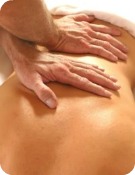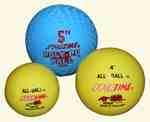
Myofascial Release is a deep tissue form of bodywork, which targets the Fascia to provide pain, relieve that last! Fascia is the connective tissue that holds our bodies together. Fascia restrictions puts abnormal pressure on nerves, muscles, blood vessels, bones, organs, and the brain, resulting in inefficient function if these structures. Pain, restriction of motion and structural misalignment are some of the consequence. Myofascial Release techniques will free up the “straightjacket” of pressure, and release holding patterns throughout the body.
Most of us have experienced back pain at some point in our lives. You may choose many different paths in order to bring about relief from the pain. Your physician may give you anti-inflammatory medications and tell you to rest. You may go to physical therapy, and have a hot pack on your back, be given a number of exercises, and continue this three times a week for six weeks. At the end you may feel some relief, unsure of whether it was the therapy or time itself. You see your chiropractor, but it seems that relief, if any, only remains if we keep going back for more adjustments. Massage certainly feels good, but did it help the pain in a lasting way?
Have any of the people you have seen for back pain looked in the front of your body? So often, the musculature and fascia (connective tissue) deep in the front of the low back become shortened, through excessive sitting and through overuse. Add onto that any pelvic surgeries or childbirth and the deep musculature becomes shortened to the point where it is pulling back so far that the “real” back muscles go into spasm, creating pain.
Treating only the back will seldom get to the source of the pain. Myofascial Release addresses all areas, concentrating on the deep musculature of the front of the back and the spine can resume its normal place.
Myofascial Stretching Tools
Myofascial Release (hands-on treatment by a therapist) and Myofascial Stretching (self-treatment using Myofascial Release principles) are dramatically effective in reducing pain and improving quality of life. This is often the missing link in resolving problematic cases of pain and dysfunction.
Video
Think of fascia as your inner bodysuit – a system of densely woven connective tissue that covers you from head to toe. It twists around your organs, muscles, nerves, arteries and veins, providing essential stability and support. It’s the primary focus of myofascial release, an intense therapy that digs deep to heal the fascia below.
Under pressure
Healthy connective tissue is supremely flexible, but damage of any kind – through surgery, injury, even years of bad posture – can restrict your range of motion and trigger painful pressure.
At the Myofascial Pain Relief Center in Rochester, N.Y., physical therapist Walt Fritz helps clients overcome pain with the therapy. He begins each session by studying a client’s posture for alignment irregularities that could be contributing to the pain. He then assesses the overall health of the client’s connective tissue, targeting the least flexible areas. “Injured fascia doesn’t give like healthy tissue,” he says.
Finally, using his hands, he applies gentle but sustained pressure for a minimum of two minutes on the most affected areas. The technique reduces the built-up tension and rigidity of a specific section of connective tissue. Unlike yoga or massage – which Fritz calls a “short-term stretch” – manipulating fascia is meant to have a structural effect. “Myofascial’s goal is to make long-lasting changes in the health of the connecting tissue,” he explains.
Unlike Rolfing or deep-tissue massage, a myofascial release session isn’t necessarily painful. A trained practitioner will not force a release that doesn’t come naturally, and every person has multiple layers of stiffness that may require several secessions to breakthrough. Also, the most direct route is not always the most effective path to recovery. For example, Fritz often treats back pain from the front of the body and will focus on tight quadriceps to solve knee problems.
DIY relief
While it’s best to see a trained myofascial practitioner for serious treatment, you can access the fascia through everyday stretching. Whether it’s a 10-minute stretch after a run, or a two-hour yoga class, you can shift your movements from the muscular surface to the deeper recesses of the connective tissue. Instead of pushing immediately to your end range – the farthest you can stretch without hurting yourself – stop when you begin to feel the first resistance. “The body goes into protective mode when you reach for an end-range stretch,” Fritz explains. “People should hold their stretches for at least two minutes and work toward extended-duration stretches” says Marisa Lowenstein.
Fascia also plays an important role in the support of our bodies, since it surrounds and has attachments to all structures. These structures would not be able to provide the ability without the constant pull of the fascia system. In fact, our bones can be thought of as tent poles, which cannot support the structure without the constant support of the guide wires (or fascia) to keep an adequate amount of tension to allow the tent (or body) to remain upright with proper equilibrium.
In the normal healthy state, the fascia is relaxed and wavy in configuration. It has the ability to stretch and move without restriction. When we experience physical trauma, scarring, or inflammation, however, the fascia looses its pliability. It becomes tight, restricted and a source of tension to the rest of the body. Trauma, such as a fall, whiplash, surgery or just habitual poor posture over time and repetitive stress injuries has a cumulative effect. The changes they cause in the fascial system comfort and the functioning of our body. The fascia can exert excessive pressure producing pain or restriction of motion. They affect our flexibility and stability, and are a determining factor in our ability to withstand stress and strain.
The use of Myofascial Release allows me to look at each patient as a unique individual. Our one-on-one therapy sessions are hands-on during which I use a multitude of Myofascial techniques and movement therapy. We promote independence through education in proper body mechanics and movement, through the enhancement of strength, flexibility, and postural and movement awareness.
While Myofascial Release may share some commonalities with traditional massage, it is a modality that reaches deeper and creates lasting change. It shares a common goal with standard physical therapy practice, however works from a different perspective. In a traditional physical therapy setting, pain is often viewed as a result of weakness. Strengthening an already tight system often only makes the problem worse. Myofascial Release relieves the tightness and pressure from your body, allowing strength and function to return in a natural manner and returning you to your desired state.

